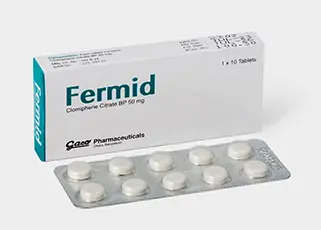Indication:
Clomiphene citrate is indicated for the treatment of ovulatory dysfunction in women desiring pregnancy. Impediments to achieving pregnancy must be excluded or adequately treated before beginning Clomiphene citrate therapy. Those patients most likely to achieve success with Clomiphene therapy include patients with polycystic ovary syndrome, amenorrhea-galactorrhea syndrome, psychogenic amenorrhea, post-oral-contraceptive amenorrhea, and certain cases of secondary amenorrhea of undetermined etiology. Properly timed coitus in relationship to ovulation is important. A basal body temperature graph or other appropriate tests may help the patient and her physician determine if ovulation occurred. Once ovulation has been established, each course of Clomiphene citrate therapy should be started on or about the 5th day of the cycle. Long- term cyclic therapy is not recommended beyond a total of about six cycles (including three ovulatory cycles). Clomiphene citrate tablets BP is indicated only in patients with demonstrated ovulatory dysfunction who meet the conditions described below: 1. Patients who are not pregnant. 2. Patients without ovarian cysts. Clomiphene citrate should not be used in patients with ovarian enlargement except in those with polycystic ovary syndrome. Pelvic examination is necessary prior to the first and each subsequent course of Clomiphene citrate treatment. 3. Patients without abnormal vaginal bleeding. If abnormal vaginal bleeding is present, the patient should be carefully evaluated to ensure that neoplastic lesions are not present 4. Patients with normal liver function. In addition, patients selected for Clomiphene citrate therapy should be evaluated in regard to the following: 1. Estrogen Levels: Patients should have adequate levels of endogenous estrogen (as estimated from vaginal smears, endometrial biopsy, assay of urinary estrogen, or from bleeding in response to progesterone). Reduced estrogen levels, while less favorable, do not preclude successful therapy. 2. Primary Pituitary or Ovarian Failure: Clomiphene citrate therapy cannot be expected to substitute for specific treatment of other causes of ovulatory failure. 3. Endometriosis and Endometrial Carcinoma: The incidence of endometriosis and endometrial carcinoma increases with age as does the incidence of ovulatory disorders. Endometrial biopsy should always be performed prior to Clomiphene citrate therapy in this population. 4. Other Impediments to Pregnancy: Impediments to pregnancy can include thyroid disorders, adrenal disorders, hyperprolactinemia, and male factor infertility. 5. Uterine Fibroids: Caution should be exercised when using Clomiphene citrate in patients with uterine fibroids due to the potential for further enlargement of the fibroids. There are no adequate and well- controlled studies that demonstrate the effectiveness of Clomiphene citrate in the treatment of male infertility. In addition, testicular tumors and gynecomastia have been reported in males using Clomiphene. The cause-and-effect relationship between reports of testicular tumors and the administration of Clomiphene citrate is not known. Although the medical literature suggests various methods, there is no universally accepted standard regimen for combined therapy (i.e., Clomiphene citrate in conjunction with other ovulation-inducing drugs). Similarly, there is no standard Clomiphene citrate regimen for ovulation induction in in vitro fertilization programs to produce ova for fertilization and reintroduction. Therefore, Clomiphene is not recommended for these uses.
Dosage & Administration:
Ovulation most often occurs from 5 to 10 days after a course of clomiphene citrate. Coitus should be timed to coincide with the expected time of ovulation. Appropriate tests to determine ovulation may be e useful during this time. Recommended Dosage Treatment of the selected patient should begin with a low dose, 50 mg daily (1 tablet) for 5 days. The dose should be increased only in those patients who do not ovulate in response to cyclic 50 mg Clomiphene citrate. A low dosage or duration of treatment course is particularly recommended if unusual sensitivity to pituitary gonadotropin is expected, such as in patients with polycystic ovary syndrome. The patient should be evaluated carefully to exclude pregnancy, ovarian enlargement, or ovarian cyst formation between each treatment cycle. If progestin-induced bleeding is planned, or if spontaneous uterine bleeding occurs prior to therapy, the regimen of 50 mg daily for 5 days should be started on or about the 5th day of the cycle. Therapy may be started at any time in the patient who has had no recent uterine bleeding: When ovulation occurs at this dosage, there is no advantage to increasing the dose in subsequent cycles of treatment. If ovulation does not appear to occur after the first course of therapy, a second course of 100 mg daily (two 50 mg tablets given as a single daily dose) for 5 days should be given. This course may be started as early as 30 days after the previous one after precautions are taken to exclude the presence of pregnancy. Increasing the dosage or duration of therapy beyond 100 mg/day for 5 days is not recommended. The majority of patients who are going to ovulate will do so after the first course of therapy. If ovulation does not occur after three courses of therapy, further treatment with Clomiphene citrate is not recommended and the patient should be re-evaluated. If three ovulatory responses occur, but pregnancy has not been achieved, further treatment is not recommended. If menses does not occur after an ovulatory response, the patient should be re-evaluated. Long-term cyclic therapy is not recommended beyond a total of about six cycles.

